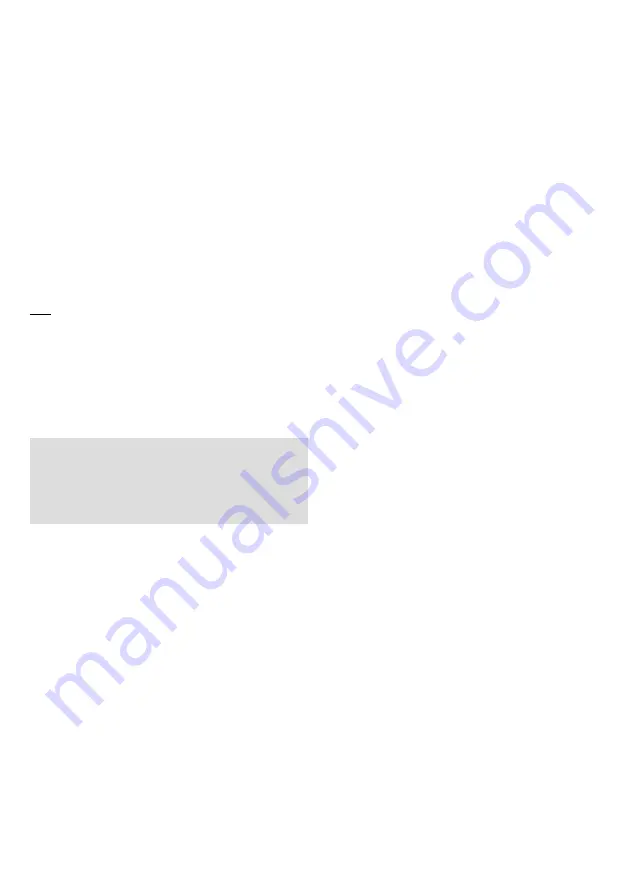
14
1.1 IMPORTANT INFORMATION
Read carefully all the operating instructions, safety pre-
cautions and warnings in the Instruction Manual. Most
accidents that occur when using the compressor are
caused by failure to observe basic safety rules. Accidents
can be avoided by recognising a potentially hazardous
situation in time and by observing appropriate safety
procedures.
Basic safety precautions are outlined in the “SAFETY”
section of this manual.
The hazardous situations that must be avoided to pre-
vent risks of serious injuries or damage to the machine
are indicated in the “WARNINGS” section.
Never use the compressor inappropriately. Only use it as
recommended by the manufacturer.
Key:
WARNING:
indicates a potentially hazardous situation
which, if ignored, could result in serious damage or
injury.
CAUTION:
indicates a hazardous situation which, if
ignored, could result in moderate personal injury or
machine damage.
NOTE:
emphasizes essential information.
1.2 SAFETY RULES
IMPROPER USE AND POOR MAINTENANCE OF THIS
COMPRESSOR MAY RESULT IN BODILY INJURY. TO
AVOID THESE RISKS, PLEASE ADHERE STRICTLY TO
THE FOLLOWING INSTRUCTIONS.
1. NEVER TOUCH MOVING PARTS
Never place your hands, fingers or other body parts near
the compressor’s moving parts.
2. NEVER OPERATE WITHOUT ALL GUARDS IN PLACE
Never operate this compressor without all the guards
and safety features (e.g. fairings, belt guard, safety valve)
perfectly fitted and in place. If maintenance or servicing
requires the removal of these guards, make sure they are
fitted properly in their original position before using the
compressor again.
3. ALWAYS WEAR EYE PROTECTION
Always wear safety goggles or equivalent eye protec-
tion. Never aim compressed air at any part of your body
or at others.
4. PROTECT YOURSELF AGAINST ELECTRIC SHOCK
Prevent accidental body contact with metal parts of the
compressor such as pipes, the tank or grounded metal
parts.
Never operate the compressor in damp or wet locations.
5. DISCONNECT THE COMPRESSOR
Always disconnect the compressor from the power
source and fully remove the compressed air from the air
tank before servicing, inspecting, maintaining, cleaning,
replacing or checking any parts.
6. UNINTENTIONAL START-UPS
Do not transport the compressor while it is connected
to its power source or when the air tank is pressurised.
Make sure the knob of the pressure switch is in the
OFF position before connecting the compressor to the
power source.
7. STORE THE COMPRESSOR PROPERLY
When the compressor is not in use, it must be kept in
a dry room protected against the weather. Keep out of
reach of children.
8. WORK AREA
Keep the work area clean, if necessary clearing the area
of any unnecessary tools.
Keep the work area well ventilated. Do not use the com-
pressor in the presence of flammable liquids or gases.
The compressor can produce sparks during operation.
Never use the compressor in situations where there
could be paint, benzene, chemicals, adhesives or any
other combustible or explosive materials.
9. KEEP CHILDREN AWAY
Prevent children or any other person from coming into
contact with the compressor power cord. All visitors
must be kept at a safe distance from the work area.
10. WORKING CLOTHES
Do not wear bulky clothes or jewellery, which could get
caught by moving parts. Wear protective hair covering
to contain long hair.
11. DO NOT ABUSE THE POWER CORD
Do not stretch the power cord when connecting the
plug. Keep cable away from heat, oil, and sharp surfaces.
Do not step on the power cord or crush it with heavy
weights.
12. MAINTAIN THE COMPRESSOR CAREFULLY
Follow instructions for lubrication (not valid for oil-less).
Inspect the power cord periodically and if it is damaged,
have it repaired or replaced by an authorized service
centre. Check the external appearance of the compres-
sor for visible abnormalities. Please contact your nearest
EN
1. FOREWORD















































